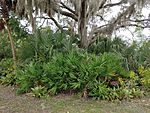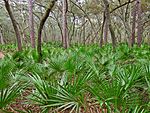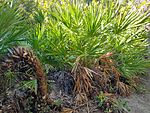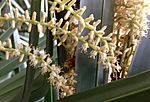Saw palmetto facts for kids
Quick facts for kids Saw palmetto |
|
|---|---|
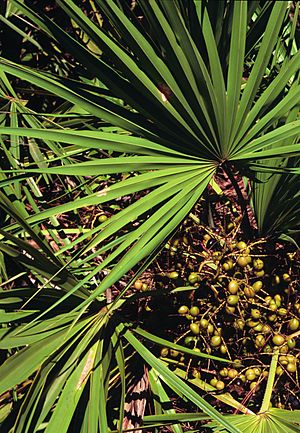 |
|
| Conservation status | |
| Scientific classification | |
| Genus: |
Serenoa
|
| Species: |
repens
|
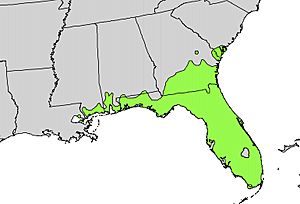 |
|
| Natural range | |
| Synonyms | |
|
Synonymy
Corypha repens W.Bartram
Corypha obliqua W.Bartram Chamaerops serrulata Michx. Sabal serrulata (Michx.) Schult.f Sabal serrulatum (Michx.) Schult.f, spelling error Diglossophyllum serrulatum (Michx.) Schaedtler Brahea serrulata (Michx.) H.Wendl. Serenoa serrulata (Michx.) Hook.f. ex B.D.Jacks. Serenoa repens f. glauca Moldenke |
|
The saw palmetto (scientific name: Serenoa repens) is a special type of small palm. It is the only species in its group, called Serenoa. This plant usually grows to be about 2 to 3 meters (7 to 10 feet) tall.
You can find saw palmetto mainly in the warm, sunny southeastern United States. It grows along the Atlantic and Gulf coasts, especially in sandy areas. It often forms thick groups or grows under pine trees and in hardwood forests.
Contents
Discover the Saw Palmetto Plant
Saw palmetto plants are very tough and can live for a long time. Some plants in Florida might even be 500 to 700 years old! They grow very slowly.
Leaves and Stems
This palm is known as a "fan palm" because its leaves look like a fan. Each leaf has a long, bare stem called a petiole. At the end of the petiole, there's a round fan made of about 20 smaller leaf parts called leaflets.
The petiole has small, sharp teeth or spines. These spines are why it's called "saw palmetto." Be careful when you are near these plants, as the spines can easily cut your skin!
The leaves are usually light green. However, near the coast, they can be a silvery-white color. The entire leaf, including the petiole, can be 1 to 2 meters (3 to 6 feet) long. The leaflets themselves are about 50 to 100 centimeters (20 to 40 inches) long.
Flowers and Fruit
Saw palmetto plants produce yellowish-white flowers. Each flower is small, about 5 millimeters (0.2 inches) across. These flowers grow in large, branched clusters up to 60 centimeters (2 feet) long.
The plant also grows a large, reddish-black fruit. This fruit is a type of drupe, which means it has a fleshy outer part and a hard pit inside. This fruit is an important food source for many wild animals. In the past, people also ate it.
Who Named It?
The scientific name Serenoa was given to honor an American botanist named Sereno Watson.
Saw Palmetto in Health Research
Scientists have studied extracts from saw palmetto. They wanted to see if these extracts could help with certain health issues, especially those affecting men's urinary systems.
As of 2018, there isn't enough strong scientific proof that saw palmetto extract can treat serious illnesses. However, some studies suggest it might help with some urinary problems. For example, a 2016 review looked at a specific saw palmetto extract. It found that this extract was safe and might help reduce certain urinary symptoms compared to a placebo (a fake treatment).
How People Used Saw Palmetto in the Past
Native American groups had many names for saw palmetto. For example, the Choctaw people called it tala, and the Timucua called it cani.
People used saw palmetto for different purposes:
- Building: The leaves were often used for thatching, which means making roofs for houses. This was so common that a place in Florida is named Kanapaha, meaning "palm house."
- Trade: Saw palmetto fibers have been found far from where the plant grows naturally. This suggests that these materials were traded widely between different groups of people long ago.
- Medicine: The fruit might have been used by the Seminoles and Bahamians to treat a type of fish poisoning.
See also
 In Spanish: Palmito salvaje para niños
In Spanish: Palmito salvaje para niños



